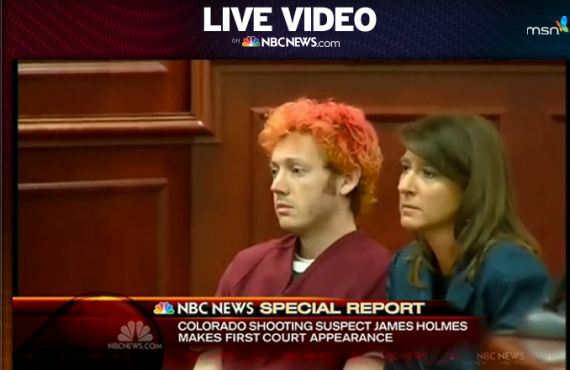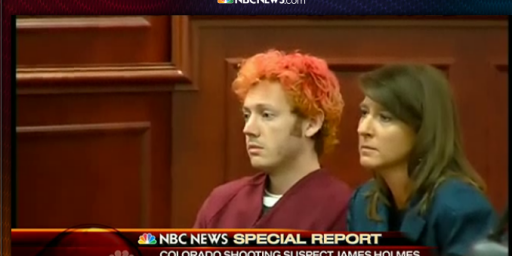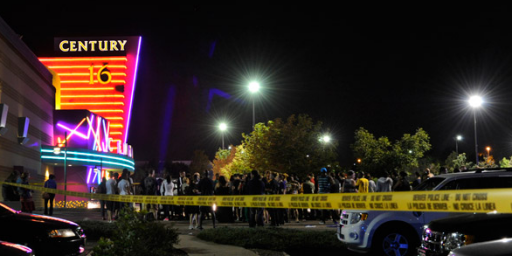Report: Psychiatrist Warned College About James Holmes
A Denver area television station is reporting that the psychiatrist who had been treating James Holmes before last month’s shootings in Aurora, Colorado had warned officials at Colorado University that he could be dangerous:
DENVER – The psychiatrist treating accused Aurora theater gunman James Holmes was so concerned about his behavior that she notified other members of the University of Colorado Behavioral Evaluation and Threat Assessment, or BETA, team that he could potentially be a danger to others, sources with knowledge of the investigation told CALL7 Investigators.
Those concerns surfaced in early June — almost six weeks before the shooting, sources told CALL7 Investigator John Ferrugia.
Sources say Dr. Lynne Fenton, who treated Holmes this spring, contacted several members of the BETA team in separate conversations. According to the university website, the BETA team consists of “key” staff members from various CU departments who have specific expertise in dealing with assessing potential threats on campus. And, sources say, officials at the University of Colorado never contacted Aurora police with Fenton’s concerns before the July 20 killings.
ABC News learned Fenton was a key member in setting up BETA in 2010, and she is currently one of the contacts for anyone who has concerns about an on-campus threat. A University of Colorado spokeswoman acknowledged that Fenton is one of several trained CU contacts who can convene the team in consultation with the chairman.
“Fenton made initial phone calls about engaging the BETA team” in “the first 10 days” of June but it “never came together” because in the period Fenton was having conversations with team members, James Holmes began the process of dropping out of school, a source said.
Sources did not know what Holmes told Fenton that sparked her concern.
“It takes more than just statements,” said one source, explaining that Holmes would have had to tell Fenton “something specific” before she would have to report it to law enforcement.
“He would have to tell her he had taken steps to make it happen,” said another source.
But an expert in threat assessment told ABC News that the warning signs were there, and CU should likely have done more when Holmes quit the university.
“I think that is the signal that you should intensify your efforts — not walk away,” said Barry Spodak.” Under those circumstances, most well-trained assessment teams would have gone into action.”
It’s unclear that anything the team, or Fenton, could have done would have prevented this tragedy, but it’s certainly not surprising to learn that there were warning signs there before Holmes acted out violently. We saw the same thing with Jared Loughner, the man who shot Congresswoman Gabby Giffords and 18 other people in Tucson in January 2011, who was barred from his college after several incidents of bizarre behavior. That solved the problem for the school, but it didn’t do anything to help Loughner who ended up committing mass murder just four months later. For Holmes, it was only a matter of weeks.





NPR did their thing where they go and talk to the families of previous mass murderers. There was a very sad story of a Texas couple who tried to raise their kid well, Scouting, the whole thing. When he started to have problems they got him counseling. Later, they actually went to court to seek institutionalization. His mom described going to court, more than once, to ask that her son be put away.
The state of Texas would not institutionalize.
The kid flipped out, and killed 5 people, including children.
The state of Texas denied him the insanity defense.
The state of Texas executed him as a killer.
That saga is exactly what’s wrong with American crime and punishment. We have terrible standards of “crazy.” You can be so crazy that your mom wants you put away. The state can deny it, because you aren’t crazy enough. And then it will try you as a sane person.
Therapists have ethical obligations of confidentiality, that can only be overcome with specificity and certainty. If Holmes had described a violent plot, I would expect a therapist to report it to law enforcement. I suspect here though Holmes did not share these thoughts, and what the therapist was concerned about was evidence of developing paranoid schizophrenia. Complications are that mental health is not a static state; nor is there a simple blood test. They would have to be looking at ways to encourage Holmes to take voluntary actions or look at establishing legally competent evidence to take away Holmes’ freedom.
I don’t envy the therapist dealing with these types of issues.
Color me skeptical of that report. Smells a lot like a TV station trying to gin up its ratings. But let’s go ahead and assume arguendo the report is accurate and not made up and such. Not sure it really tells us anything. Could the college have done more? Sure. But hindsight always is 20/20 and obviously we wouldn’t want colleges calling in the police calvary every time a young student got twitchy.
As far as reading the tea leaves of warning signs, my understanding is that it’s not as simple as it would appear, especially with spree and serial killers. As I understand it sometimes the really twitchy ones simply are malingering and sometimes it really is the dude next door who snaps and goes on a killing spree. The best sources for the true answers are forensic psychiatrists and forensic neuropsychiatrists, certainly not the media and most often not even those quoted by the media.
Oops, “police cavalry,” that is.
@john personna:
What should be the standard for confining some one in a hospital?
Dating back to the 50’s the courts have developed a standard that a recent overt act of self harm/dangerous behavior due to a mental disorder for which the least restrictive alternative is the state hospital proven in a hearing is needed.
@john personna: The problem is that back when it was easier to commit someone, there were a number of people who were “so crazy” that their mom or somebody else wanted them put away, but who never would have done anything. The state was actually consistent both before and afterwards, for that matter, in the case you mention; in neither case did they find the person crazy.
I certainly don’t doubt that nearly everyone who commits these crimes shows some kind of warning signs. But a lot of people who show warning signs don’t do anything.
Kenneth Donaldson, whose case went to the Supreme Court in 1975, was “so crazy” that his dad wanted him locked up. But the Supreme Court said that we couldn’t, because there was no evidence. That ruling helped continue and codify the process of deinstitutionalization.
How many lives should be ruined and denied liberty in order to prevent one of these actions? Hard question to answer.
@walt moffett, @John Thacker:
I think “likely to harm self, others” is still the criteria that should be used to put someone away.
But really my focus is on the other side, crime and punishment. It is not really a “feature” when you call a crazy person sane and put him into the conventional criminal justice system. It is a “bug.”
I would like to see many more people tried with recognition of diminished capacity, but for me that should not remove the real possibility of long sentences or life imprisonment. AFAIK, Holmes should go to a mental institution for the rest of his natural life. If he, or his doctor, think he’s cured in 20 years, you say “that’s great, but you know, the killing thing, life imprisonment.”
If he’s sane at that point, he should recognize the punishment as fair.
I don’t think that you can separate the crime and punishment from institutionalization. If you argue that people don’t have rational control, then you eliminate the distinction between having committed an act and psychologists being sure that you will. In which case your call for more insanity defenses will lead to more involuntary institutionalization.
If you do say that people have a choice, then I am not sure what the case is for treating them differently from any other type of criminal, all of whon their own, generally flawed, reasons.
Though I do think that our prisons are too full, too many things are felonies, and treatment is barbaric. I don’t think that substituting institutionalization is tge answer, though.
@John Thacker:
I have read a series of books on modern mind/brain theory. My focus was really the bridge from brains to finance, but I saw a bit about action, volition, and control. I liked Descartes’ Error by Damasio, The Blank Slate by Pinker, The Winner’s Curse by Thaler, Cheating Monkeys and Citizen Bees by Dugatkin.
I didn’t see anything in them to justify the legal definition of insanity that at the time of the crime, the person did not appreciate the nature or quality or wrongfulness of the acts.
That is based on an old, single-threaded, cognitive view of decision making. We now know that it’s a society of mind thing, with many decisions made unconsciously and only defended later by a post-hoc stream of rationalization.
For that reason this isn’t going to be precise. We should make institutionalization decisions based on how hard the yellow light is flashing, and then make decisions of competency based on whether the yellow light was there at all.
@ John Thacker
Being institutionalized may well save the life of someone who is mentally ill, not “ruin” it.
@john personna:
Remember, since the days of Hammurabi, the State acts on what people do (or don’t do) instead of what they’re likely to do. Confining some one simply because the judge concludes after hearing from family and experts, they could do something is out of Kafka.
Re: not guilty by reason of insanity, a fun case is that of Jeremy Bentley, found not guilty by reason of insanity ( a rarity in Alabama), committed to state hospital for the criminally insane, after a few years the hospital staff concludes he has an untreatable personality disorder, is dangerous and any signs of psychosis is malingering. So, largely based on the idea they can’t treat him he should be released. Which leads me to think a vulnerable population’s worst enemy are the experts treating/advocating for them.